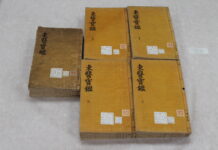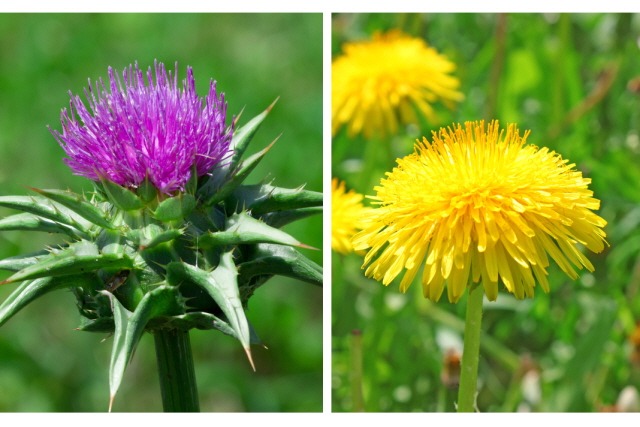Milk Thistle Relieves Liver Stagnation, and Dandelion Expels Detoxified Chemicals
By Dae Sun Hong, L.Ac.
Herbal formulas have been formulated with multiple herbs to treat the target symptom and suppress the potential side effects of certain herbs. We can expect synergistic effects of the two herbs as we use dandelion and milk thistle to help with the liver. Let’s find out each herb’s characteristics and indications and the mixed formula of these two herbs.
Dandelion, a Cooling herb
According to Dongui Bogam, Treasured Mirror of Eastern Medicine, the nature of the dandelion is mild, its taste is bitter and sweet, and it is poison-free and moderately cold. The herb is mainly used for breast abscesses in women. The herb can be found everywhere in Korea, and its leaves look like Ixeris Chinensis Nakai Subsp. Versicolor, its yellow flowers resemble the chrysanthemum blooms from March to April. White sap can be seen from the cut when the stem and leaves are picked. The sap is edible. In Korean, the herb is called Pogongyeong in Eastern medical terminology. It removes heat toxins or pathogens and malignant swelling, breaks subcutaneous nodes, and eliminates food toxins. It provides benefits by driving stagnated qi downward and entering the yang brightness meridian and greater yin meridian. It is known for treating deep-rooted boils.
The herb has been used to cool the heat toxin; therefore, it has been prescribed to cure an infection, furuncle, inflammation-related symptoms, and various symptoms shown on the skin. The other indications of the herbs are difficulty in urination, indigestion, immunodeficiency, boil, soar throat, appendicitis, lung abscess, peritonitis, red eyes, acute hepatitis, and jaundice.
Recently, the herb has received attention for its ability to help various liver conditions and diseases.
The active ingredient of the dandelion is vitamin A and C, which are considered a strong antioxidant, vitamin B and D groups, Iron, Magnesium, Zinc, Potassium, Mangan, Copper, and Choline.
The herb’s root has been used in Western culture to treat liver and gall bladder symptoms. Also, breast diseases, dropsy, indigestion, joint pain, fever, and skin diseases. Also, the root is used as a tea to enhance appetite.
Much research found that eudesmanolide and germacranolide are active pharmaceutical agents of dandelion.
Milk Thistle, Enhancing and Restoring Liver Function
Milk Thistle also has been used for a long period in Asian medicine. According to Donguibogam, the herb has a bitter taste but is not toxic. The herb could be used to resolve blood stagnation and nosebleed or hematemesis. The characteristics of the herb are warm, and it enters the heart and liver. The herb should be used to stop bleeding due to excessive heat in the blood. In general, the herb is used for stopping various bleeding symptoms.
The Korean name of the herb, Unggumquey, came from its blood clotting function. The herb’s active ingredient is silymarin, with at least seven other chemical compounds. Silymarin has the distinctive and strongest treatment effects, detoxifying toxic mushrooms. In vitro, silymarin was proven to successfully detoxicate toxic liver damage from alcohol, and acetaminophen, an active ingredient of Tylenol and toluene.
Milk thistle is also helping damaged liver cell regeneration, preventing toxic chemicals from damaging liver cells and stabilizing the cell walls of the liver. Therefore, Milk thistle is considered one of the strongest antioxidants, and many researchers are performing to study more of the herb in the Western world.
Milk thistle is expected to suppress cancer cell regeneration in cancer patients. The herb could be recommended for one who has various hepatitis, liver cirrhosis, and hepatotoxin medicine taking. Also, it is applied to one who has gall bladder diseases, lower cholesterol level, breast cancer, ineffective insulin resistance, prostate cancer, and cervical cancer.
Synergistic Effects and Precautions
Dandelion and Milk thistle work on the liver to restore its normal function. As both herbs are used simultaneously, Milk thistle mainly resolves liver stagnation and detox. Then dandelion helps detox process of the milk thistle’s liver detox indirectly and completes the process through a diuretic effect, expelling any toxic chemical outside of the body. Also, dandelion has cold characteristics, but milk thistle’s warm characteristics compensate for enhancing the balance of temperature to prevent side effects from cooling down body temperature.
As both herbs are used together, the synergistic effects are enormous for myiodesopsia, stress-educed diarrhea, tension, repressed feelings, headaches, irregular menstruation, high cholesterol and glucose level, and even hangover. Here are more indications for using dandelion and milk thistle:
Mood swings, skin trouble, neck and shoulder pain, various sleeping disorders, loss of competency and self-downing, anxiety symptoms, frequent fatigue, inability to concentrate, abnormal appetite, loss of memory, heart palpitation, and loss of interest in anything.
There are many herbal mixtures in the milk thistle and dandelion market. But in some cases, the herbal mixture could cause nausea and diarrhea. Therefore, it requires precautious for using one who has chronic indigestion, pregnant women, and hypoglycemia patients.




































